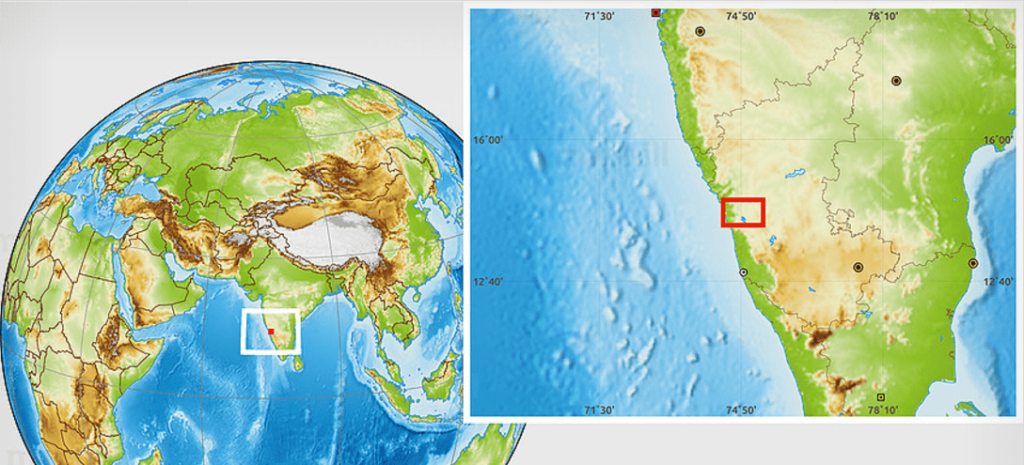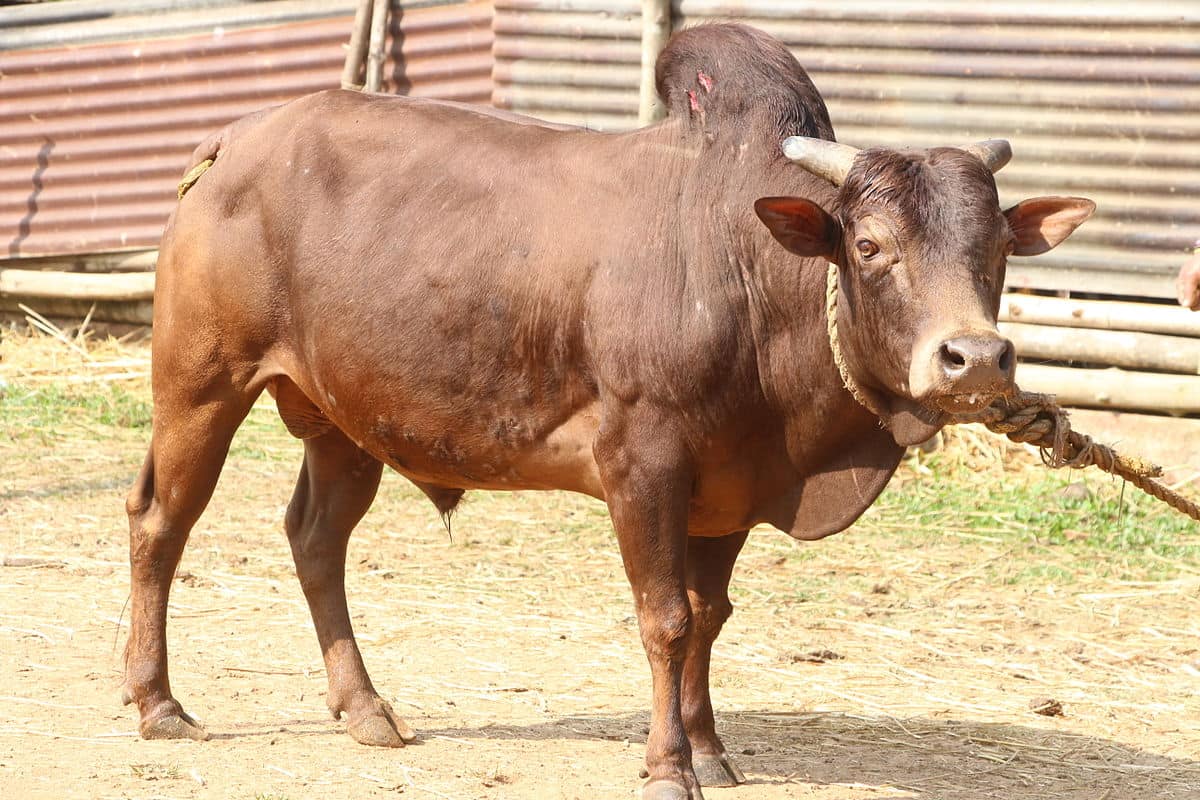The word gidda means dwarf and Malnad means a place receiving heavy rainfall.
Malnad Gidda Cattle Breed:
Breeding status: Conservation
Country: India, Karnataka
Home or breeding tract: Malnad Gidda cattle are small size animals and distributed and Maintained in Malnad/Malenadu area of Karnataka. The breeding tract of this breed also includes Chikmagalur, Dakshin Kannada, Hassan, Kodagu, Shimoga, Uttar Kannada and Udupi districts of Karnataka.
Body: Malnad Gidda is one of the Indian dwarf breeds, hence the size of the cattle will be small when compared to other average Indian indigenous cattle. They are small with compact body frame and adult animals are around 90 centimetres tall.
Body colour: Colours found in these animals (black, brown, red, fawn and white, sometimes the mixture of any of these) but the black colour was predominant.

Markings over the body: light shades of fawn on the thigh and shoulder region.
Head: Dark
Face: Narrow
Ears: Small, pointed
Neck: Dark
Dewlap: Thick
Shoulder hump: small and dark
Penis sheath flap: Very small
Horns: Horns are generally small and black in colour.
Production traits: it is zero input system where animals sustain solely on grazing. Elite cows give 3-5 kg of milk per day and the average lactation yield is around 220 Kg.
Ability as draught purpose: They play a major role in the rural economy of this region by providing milk, manure and draught purpose.
Other Names: It is also called Malenadu Gidda, Gidda, Uradana and Varshagandhi..
Malnad Gidda cattle are small size animals and distributed in Malnad area of Karnataka. The population of the breed is about few lakh in Karnataka but is showing a declining trend. This breed has not been included in the list of recognised cattle breeds of India due to lack of information about the breed. A survey was undertaken in the 23 villages of 3 taluks of Shimoga district and 4 talukas of Chikmagalur district of Karnataka state. Data were collected for management, phenotypic characteristics, morphometric traits, production and reproductive performance on 398 animals belonging to 41 farmers. There were 5 coat colours found in these animals (black, brown, red, fawn and white, the sometimes mixture of any 2) but the black colour was predominant. Average body length, height at withers and chest girth were 87.04±O.65, 90.29±0.46, and l18.36±O.67 cm for cows and 86.53±1.93, 91±1.47 and 118.47±3.93 cm for adult males, respectively, indicated the small size of Malnad Gidda breed among all the known cattle breeds of India. The herd size varied from 3 to 35 animals. The average daily milk yield of elite cows was obtained as 2.11 kg. The age at first service in males, age at first calving of cows, service period, dry period and calving interval, were 38.06±1.24 months, 45.41±1.22 months, 8.38±1.03 months, 7.17±O.53 months and 17.02±O.68 months, respectively. Animals of this breed are playing a significant role in the rural livelihood of Malnad area of Karnataka in terms of drought, milk and manure. There is a need to take up a systematic genetic improvement programme and sustainable measures for the conservation of the population of this breed.
Malnad Gidda cattle breed is a native of Western Ghats in Karnataka. The word gidda means dwarf and Malnad means a place receiving heavy rainfall.
At present this cattle breed is distributed predominately in Malnad areas of Shimoga, Hassan, Chikmagalur and adjacent coastal districts of Mangalore, Udupi, North Kanara and parts of Kodagu districts of Karnataka.
Small size
The animals are small in size with a compact body frame weighing 80-120 kgs. Malnad breed is short in height and smaller compared to Vechur and Kasaragod cattle of Kerala and Punganur cattle breed of Andhra Pradesh.
The animals are active and resistant to major diseases such as foot and mouth disease which affects cattle.
Well adapted
They are well adapted to the Western Ghats and have become an inseparable part of the farming community, providing milk, manure and draft power, according to Prof. M.G. Govindaiah, Special Officer, Karnataka Veterinary Animal and Fishery Sciences University (KVAFSU), Hebbal, Bangalore.
The skin colour in a majority of the animals is black with light shades of fawn on the thigh and shoulder regions. Brown coloured animals with light fawn shades are also seen.
The hooves, eyelids, tail switch (hair at the end of the tail), and horn are black in colour. A small hump is seen in males, while females have a bowl-shaped udder. The teats are funnel in shape being broader at the base, narrowing downwards and ending with pointed tips.
The tail is long and the tail switch almost touches the ground. This breed yields 0.5 to 4 litres of milk per day with a fat content of 5.5 to 8 per cent. The animals remain in milk for about 250 days in a year. The average lifespan of an adult animal is 9-12 years.
Naturally robust
No special care is needed to rear these animals. During night time the animals can be housed in roughly built sheds or tied under trees.
If the animals are housed in a shed it is usual practice to spread green leaves and/or twigs on the floor every day as bedding material for the animals. The dung and urine are cleared in once a month or two and applied to the fields which form good quality compost manure.
Animals are mostly sent for grazing. They are also fed with small quantities of paddy straw, and green grass depending on their availability.
Traditional feed
Some farmers feed a traditional concentrate mixture called Maddi (horse-gram chunni, broken rice, oil-cake and rice flour) at the time of milking of the animals.
“The animals are generally bred by natural service and artificial insemination (AI) is not prevalent for this breed,” Prof Govindaiah said.
Regarding the cost of the animal, he said, a female animal of 2-3 years of age costs Rs.2,000-3,000 and a male animal is priced Rs.3,000-5,000.
At present, there is an urgent need to conserve this breed in view of its disease resistance and adaptability to hot and humid conditions of the Malnad region.
Frequent mating with other breeds to increase milk production has led to genetic dilution and erosion of this breed.
Source: animalhusbandrykaikalur.blogspot.in
Need Support:
We are currently searching for additional photographs and information on this breed. If you have materials which we could borrow or if you know of a potential source please contact us using the comment form below.
Read More: Other Native cattle
For More information and purchase on different indigenous breeds
Alambadi Cattle | Amrit Mahal Cattle | Bachaur cattle | Bargur Cattle | Gir Breed |Kasaragod Dwarf Cattle | Kherigarh Cattle | Krishna Valley cattle | Malnad Gidda Cattle | Mewati Breed | Ongole breed cattle | Ponwar Breed | Pulikulam Cattle | Umblachery Cattle | Vechur Cattle Breed
Read More: Native Dog breed
For More information on Indian native dog breeds.
Banjara Greyhound | Bully kutta mastiff | Chippiparai Hound | Gaddi Kutta mastiff | Indian Spitz | Jonangi breed | Kanni hound dog | Kombai/Combai hound dog | Mudhol Hound | Pandikona Hound | Rajapalayam Hound | Rampur Hound
Also Read : Other Blog
How to Recognise Native British Cattle Breeds | The American Bison | Recognized indigenous cattle breeds of India | List of Bos Indicus Breeds – Zebu Breed | First Domesticated Cattle in the World : Origin of Modern Cows Traced | 40 million cows to get Aadhaar like number at cost of Rs 50 crore in 1st phase : Budget 2018 | Registration of livestock/poultry breeds rises to 169: Govt | Chennai to host expo of indigenous native cattle breeds on Jan 6 and 7. | Kerala Sets up a special reproduction centre to help grow Vechur cattle population | Andhra pradesh well poised to become a seed hub, says Bill Gates | Using Cow Dung of Indigenous Breeds, This Farmer Makes Lakhs from Organic Papaya | Kampala to host 2017 livestock show | Cargill to plough millions into animal nutrition business in India | Supreme Court issues notice to Tamil Nadu government on PETA plea against jallikattu | Haryana govt plans PGs for cattle to boost milk production | Molecular Characterisation of Rathi and Tharparkar Indigenous Cattle (Bos indicus) | Embryo transfer technology to be used to carry out 440 embryo transfers in cattle in 9 days | ‘Rettamalai Ondikaruppu’ Temple Bull , is no more | Decline in indigenous cow breeds: NGT summons official | Maharashtra moos to boost desi/Indigenous cow varieties | Soon desi cow’s milk will be sold through medical stores: Warns Rajasthan minister | Telangana ties up with Brazil to improve Desi milk production | Project Mooo: supporting India’s dairy farmers with sustainable technology | Government allocates ₹2.5 cr. for protection of native cattle breeds | Project to preserve indigenous cattle – Karnataka.| Alanganallur was the most crowded village today in India! | Tamils Gathered in America, To show Support Jallikattu!! |
